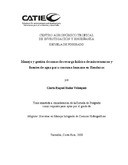| dc.description.abstract | En este estudio se analizó la situación del manejo y gestión de la zonas de recarga hídrica, principalmente de fuentes de agua para consumo humano, en Honduras y se propusieron lineamientos y criterios que apoyen a los decisores al nivel nacional, al nivel de los municipios y de las organizaciones e instituciones que tienen relación o responsabilidad directa con este tema. El análisis de los lineamientos de políticas, estrategias y acciones se realizó a partir de la recopilación de información primaria y secundaria, incluyendo la aplicación de entrevistas a actores claves de programas, proyectos e instituciones que tienen relación con el manejo y gestión de los recursos hídricos en Honduras, de la aplicación de entrevistas a actores claves de proyectos locales o comunitarios de agua para consumo humano seleccionados como estudios de caso, así como del análisis del marco legal e institucional. Le corresponde a las instituciones rectoras de los recursos, agua, bosque y suelo, principalmente al Instituto Nacional de Conservación y Desarrollo Forestal, Ã reas protegidas y Vida Silvestre y la Secretaría de Recursos Naturales y Ambiente, liderar los procesos necesarios y poner en agenda prioritaria la toma de decisiones para internalizar y viabilizar acciones concretas para enfrentar esta problemática de manera integral. In this study, the current situation related to the handling and management of hydric recharge zones was analyzed, mainly, in terMON of the use of water sources for human consumption in Honduras. Guidelines and criteria, supporting decision makers at national and municipal levels and the organizations and institutions, which have direct relation or direct responsibility with this subject were proposed. The analysis of policy guidelines , strategies and actions was made based on the compilation of primary and secondary information, including the application of interviews to key actors related to prograMON, projects and institutions showing relation with the handling and management of hydric resources in Honduras. Also, the application of interviews to key actors involved in local or community projects related to water for human consumption selected as case studies, as well as the analysis of the legal and institutional frame. It corresponds to the governing institutions in charge of the water, forest and soil resources, mainly, the National Institute of Forest Conservation and Development, Protected Areas and Wildlife (ICF) and the Secretary of Natural Resources and Environment (SERNA), to direct the necessary processes and prioritize in their agendas the decision making to internalize and facilitate concrete actions to face this problem integrally. | es_ES |


